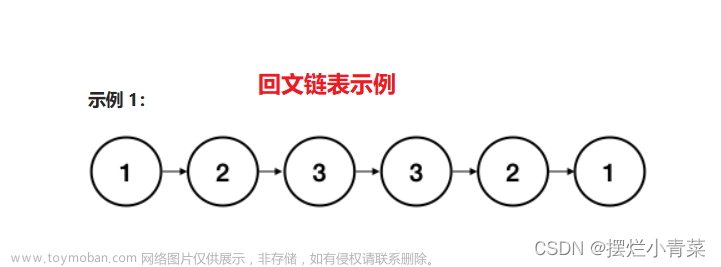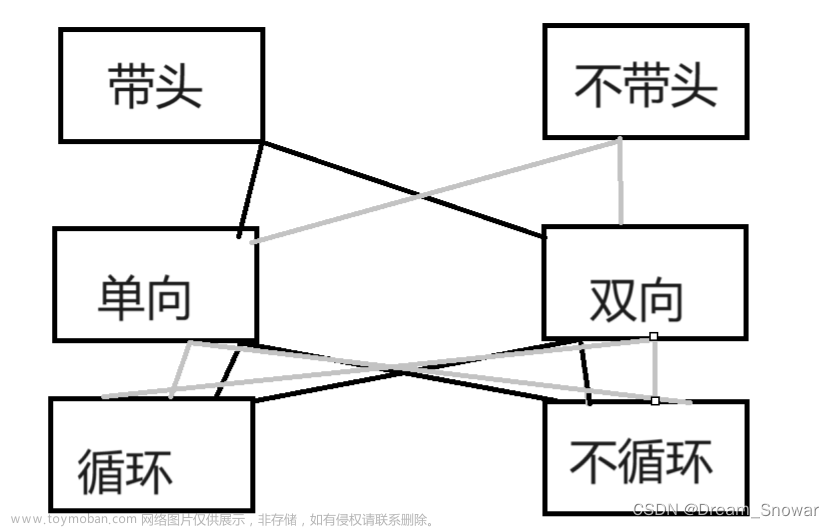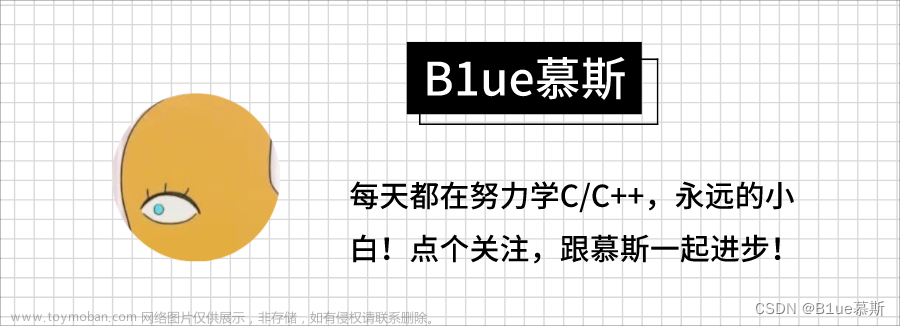
个人主页 : 个人主页
个人专栏 : 《数据结构》 《C语言》
前言
本篇博客,将要实现的是带头双向循环链表,该结构实现尾插,尾删只需要O(1)的时间复杂度。
其结构如下所示:

一、实现思路
1.节点的结构(ListNode)
既然要实现的链表是双向循环的,那么对于指针域,我们就需要指向节点上一个的指针和指向节点下一个的指针。至于双向循环,我们只需要尾节点的next指向头结点,头结点的prev指向尾节点,即可实现双向循环。
如下:
typedef int LTDataType;//方便以后修改数据类型
typedef struct ListNode
{
LTDataType data;
struct ListNode* next;
struct ListNode* prev;
}ListNode;
2.新节点的创建(BuyListNode)
动态开辟一块空间,使该节点的prev,next都指向自己(方便头结构的创建),再为data赋值,返回该空间地址。

//创建新节点
ListNode* BuyListNode(LTDataType x)
{
ListNode* newnode = (ListNode*)malloc(sizeof(ListNode));
if (newnode == NULL)
{
perror("malloc");
exit(-1);
}
newnode->data = x;
newnode->next = newnode;
newnode->prev = newnode;
return newnode;
}
3.头结点的创建(ListCreate)
复用BuyListNode函数,使头结点的data为无效数据(这里即为-1)。
//创建返回链表的头结点
ListNode* ListCreate()
{
return BuyListNode(-1);
}
4.双向链表的销毁(ListDestroy)
要销毁链表,我们就要遍历链表,那么如何遍历链表?
- 以遍历到头节点为结束条件
- 从头结点的下一个节点开始遍历
如上,我们就可以循环遍历链表。
销毁节点,我们需要两指针变量,一个记录要free的节点(cur),一个记录要free的节点的下一个节点(curNext)。每次free(cur),使cur = curNext。
//双向链表的销毁
void ListDestroy(ListNode* pHead)
{
assert(pHead);
ListNode* cur = pHead->next;
while (cur != pHead)
{
ListNode* curNext = cur->next;
free(cur);
cur = curNext;
}
free(pHead);
}
5.双向链表的打印(ListPrint)
我们只有遍历打印链表即可。
- 以遍历到头节点为结束条件
- 从头结点的下一个节点开始遍历
//双向链表的打印
void ListPrint(ListNode* pHead)
{
assert(pHead);
ListNode* cur = pHead->next;
printf("head<=>");
while (cur != pHead)
{
printf("%d<=>", cur->data);
cur = cur->next;
}
printf("head\n");
}
6.双向链表的尾插(ListPushBack)
我们只需要让尾节点(tail)的next指向newnode,newnode的prev指向尾节点(tail),newnode的next指向头结点,头结点的prev指向newnode.
我们知道该链表是双向循环的,那么头结点的上一个节点就是尾节点。(与单链表相比该链表实现尾插并不需要遍历找尾,时间复杂度是O(1) )。
//双向链表的尾插
void ListPushBack(ListNode* pHead, LTDataType x)
{
assert(pHead);
ListNode* newnode = BuyListNode(x);
ListNode* tail = pHead->prev;
tail->next = newnode;
newnode->prev = tail;
pHead->prev = newnode;
newnode->next = pHead;
}
7.双向链表的尾删(ListPopBack)
我们只需要两个指针tail (指向尾节点),tailPrev (指向尾节点的上一个节点)。
free掉tail,使tailPrev的next指向头结点,头结点的prev指向tailPrev。
- 注意:head->next == head 时,链表无有效数据,不能尾删数据。

//双向链表的尾删
void ListPopBack(ListNode* pHead)
{
assert(pHead);
//pHead->next == pHead时,链表没有元素
assert(pHead->next != pHead);
ListNode* tail = pHead->prev;
ListNode* tailPrev = tail->prev;
pHead->prev = tailPrev;
tailPrev->next = pHead;
free(tail);
}
8.双向链表的头插(ListPushFront)
我们只需要一个指针 first (头结点的下一个节点),使first的prev指向newnode,newnode的next指向first,head的next指向newnode,newnode的prev指向head。

head节点是哨兵位,不存储有效数据。
//双向链表的头插
void ListPushFront(ListNode* pHead, LTDataType x)
{
assert(pHead);
ListNode* newnode = BuyListNode(x);
ListNode* first = pHead->next;
newnode->next = first;
first->prev = newnode;
newnode->prev = pHead;
pHead->next = newnode;
}
9.双向链表的头删(ListPopFront)
我们需要两个指针frist (指向头结点的下一个节点),second (指向头结点的下一个的下一个节点)。
free掉first,使second的prev指向头结点,头结点的next指向second。
- 注意:如果head->next == head,表示链表为空,不能头删。

//双向链表的头删
void ListPopFront(ListNode* pHead)
{
assert(pHead);
assert(pHead->next != pHead);
ListNode* first = pHead->next;
ListNode* second = first->next;
second->prev = pHead;
pHead->next = second;
free(first);
}
10.双向链表的查找(ListFind)
我们需要遍历链表,比较链表元素是否是要查找对象。如果找到了,返回该节点的地址。如果找不到,返回NULL。
//双向链表的查找
ListNode* ListFind(ListNode* pHead, LTDataType x)
{
assert(pHead);
ListNode* cur = pHead->next;
while (cur != pHead)
{
if (cur->data == x)
return cur;
cur = cur->next;
}
return NULL;
}
11.双向链表在pos前插入(ListInsert)
我们需要一个指针 posPrev (指向pos前一个节点)。
pos的prev指向newnode,newnode的next指向pos;posPrev的next指向newnode,newnode的prev指向posPrev。
- 如果pos指向头结点(哨兵位),那么ListInsert相当与完成尾插。
- 如果pos指向头结点(哨兵位)的下一个节点,那么ListInsert相当于头插。

//双向链表在pos前进行插入
void ListInsert(ListNode* pos, LTDataType x)
{
assert(pos);
ListNode* newnode = BuyListNode(x);
ListNode* posPrev = pos->prev;
newnode->prev = posPrev;
posPrev->next = newnode;
newnode->next = pos;
pos->prev = newnode;
}
12.双向链表删除pos位置处的节点(ListErase)
我们需要两个指针posPrev(记录pos的上一个节点的地址),posNext(记录pos的下一个节点的地址)。free掉pos,使posNext的prev指向posPrev,posPrev的next指向posNext。
- 如果pos指向头结点的下一个,那么ListErase相当于头删。
- 如果pos指向头结点的上一个(也就是尾节点),那么ListErase相当于尾删。

//双向链表删除pos位置的节点
void ListErase(ListNode* pos)
{
assert(pos);
ListNode* posNext = pos->next;
ListNode* posPrev = pos->prev;
posPrev->next = posNext;
posNext->prev = posPrev;
free(pos);
}
二、代码实现
对于头插,尾插函数,我复用了ListInsert函数。
对于头删,尾删函数,我复用了ListErase函数。文章来源:https://www.toymoban.com/news/detail-630742.html
//Lish.h 文件
#pragma once
#include <stdio.h>
#include <stdlib.h>
#include <assert.h>
typedef int LTDataType;
typedef struct ListNode
{
LTDataType data;
struct ListNode* next;
struct ListNode* prev;
}ListNode;
//创建返回链表的头结点
ListNode* ListCreate();
//创建新节点
ListNode* BuyListNode(LTDataType x);
//双向链表的销毁
void ListDestroy(ListNode* pHead);
//双向链表的打印
void ListPrint(ListNode* pHead);
//双向链表的尾插
void ListPushBack(ListNode* pHead, LTDataType x);
//双向链表的尾删
void ListPopBack(ListNode* pHead);
//双向链表的头插
void ListPushFront(ListNode* pHead, LTDataType x);
//双向链表的头删
void ListPopFront(ListNode* pHead);
//双向链表的查找
ListNode* ListFind(ListNode* pHead, LTDataType x);
//双向链表在pos前进行插入
void ListInsert(ListNode* pos, LTDataType x);
//双向链表删除pos位置的节点
void ListErase(ListNode* pos);
//Lish.c 文件
#include "List.h"
//创建返回链表的头结点
ListNode* ListCreate()
{
return BuyListNode(-1);
}
//创建新节点
ListNode* BuyListNode(LTDataType x)
{
ListNode* newnode = (ListNode*)malloc(sizeof(ListNode));
if (newnode == NULL)
{
perror("malloc");
exit(-1);
}
newnode->data = x;
newnode->next = newnode;
newnode->prev = newnode;
return newnode;
}
//双向链表的打印
void ListPrint(ListNode* pHead)
{
assert(pHead);
ListNode* cur = pHead->next;
printf("head<=>");
while (cur != pHead)
{
printf("%d<=>", cur->data);
cur = cur->next;
}
printf("head\n");
}
//双向链表的尾插
void ListPushBack(ListNode* pHead, LTDataType x)
{
assert(pHead);
/*ListNode* newnode = BuyListNode(x);
ListNode* tail = pHead->prev;
tail->next = newnode;
newnode->prev = tail;
pHead->prev = newnode;
newnode->next = pHead;*/
ListInsert(pHead, x);
}
//双向链表的尾删
void ListPopBack(ListNode* pHead)
{
assert(pHead);
//pHead->next == pHead时,链表没有元素
assert(pHead->next != pHead);
/*ListNode* tail = pHead->prev;
ListNode* tailPrev = tail->prev;
pHead->prev = tailPrev;
tailPrev->next = pHead;
free(tail);*/
ListErase(pHead->prev);
}
//双向链表的头插
void ListPushFront(ListNode* pHead, LTDataType x)
{
assert(pHead);
/*ListNode* newnode = BuyListNode(x);
ListNode* first = pHead->next;
newnode->next = first;
first->prev = newnode;
newnode->prev = pHead;
pHead->next = newnode;*/
ListInsert(pHead->next, x);
}
//双向链表的头删
void ListPopFront(ListNode* pHead)
{
assert(pHead);
assert(pHead->next != pHead);
/*ListNode* first = pHead->next;
ListNode* second = first->next;
second->prev = pHead;
pHead->next = second;
free(first);*/
ListErase(pHead->next);
}
//双向链表的查找
ListNode* ListFind(ListNode* pHead, LTDataType x)
{
assert(pHead);
ListNode* cur = pHead->next;
while (cur != pHead)
{
if (cur->data == x)
return cur;
cur = cur->next;
}
return NULL;
}
//双向链表在pos前进行插入
void ListInsert(ListNode* pos, LTDataType x)
{
assert(pos);
ListNode* newnode = BuyListNode(x);
ListNode* posPrev = pos->prev;
newnode->prev = posPrev;
posPrev->next = newnode;
newnode->next = pos;
pos->prev = newnode;
}
//双向链表删除pos位置的节点
void ListErase(ListNode* pos)
{
assert(pos);
ListNode* posNext = pos->next;
ListNode* posPrev = pos->prev;
posPrev->next = posNext;
posNext->prev = posPrev;
free(pos);
}
//双向链表的销毁
void ListDestroy(ListNode* pHead)
{
assert(pHead);
ListNode* cur = pHead->next;
while (cur != pHead)
{
ListNode* curNext = cur->next;
free(cur);
cur = curNext;
}
free(pHead);
}
总结
以上就是双向链表的实现!!! 文章来源地址https://www.toymoban.com/news/detail-630742.html
文章来源地址https://www.toymoban.com/news/detail-630742.html
到了这里,关于数据结构:双向链表的实现(C实现)的文章就介绍完了。如果您还想了解更多内容,请在右上角搜索TOY模板网以前的文章或继续浏览下面的相关文章,希望大家以后多多支持TOY模板网!













